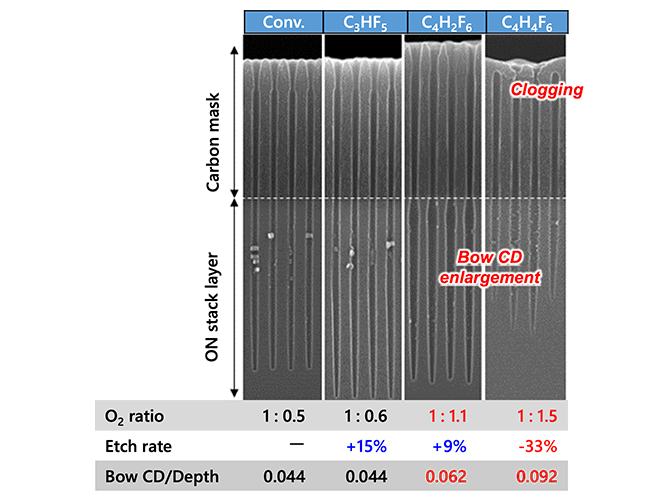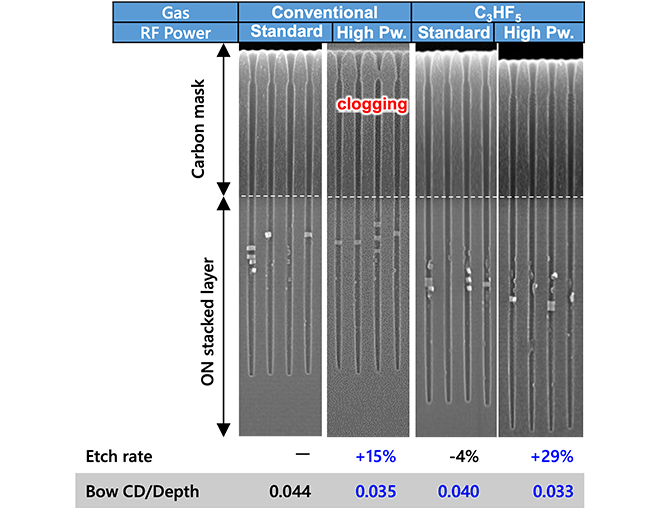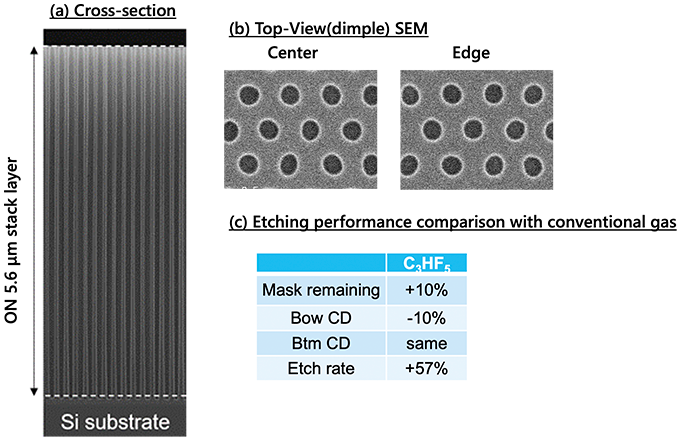Please select your location and preferred language where available.
Productivity improvement in memory hole etching technology using a novel C3HF5 gas
February 22, 2024
The manufacturing of 3D flash memory devices, requires the fabrication of extremely deep holes (Memory hole) with high precision profiles. As device bit density increases, the memory holes become much deeper and a high throughput process with controlled profiles gains importance. Here, we summarize our new etching technology using a novel, environmentally-friendly gas.
In memory hole etching, a perfect cylindrical shape minimizes variation of device performance. In reality, however, many issues can lead to non-ideal shapes such as bowing, striation and taper as shown in Figure 1[1]. To avoid such abnormalities, we should optimize the various etching parameters such as pressure, power, gas flow ratio and wafer temperature. Etching time increases for deeper holes. It is not easy to achieve simultaneous improvement in both productivity and profile. So, we focused on the gas chemistry as the foundation of the etching process. We explored novel gases with high etch rates and high profile controllability. The candidates included gases not used before in flash memory mass production.

First, we focused on etchant gas properties that may increase etch rate. Although both radicals and ions are generated inside the plasma, ions make a higher contribution to etch rates at the bottom of a deep hole due to their highly directional velocities as shown in Figure 2. So, the choice of ions is key to increase the etch rate.

Gas selection proceeded as follows: (1)selected several candidate gases by simulating etch rates (2)narrowed down the candidate gases by comparing etch rate and mask selectivity performance, (3)performed a detailed study to achieve the desired profile and determined the gas with best etching performance. We selected six candidate gases that also yielded the highest number of etched silicon atoms per impact[2]. Then, we evaluated the actual etching process with these gases, and chose three gases (C3HF5, C4H2F6, C4H4F6) described in the blue region in Figure 3 that have better etch rate and mask selectivity compared to conventional gases.

Next, we refined the etching process of each of these three gases to optimize the profile. We found that the degree of mask clogging was different among these gases as shown in Figure 4. Mask clogging is the phenomenon where the opening of mask is blocked by reaction products, causing etch-stop in the memory hole. We found that mask clogging was likely to occur if the gas contained a large number of hydrogen atoms. The severity occurred in this order, C3HF5, C4H2F6, C4H4F6. Suppression of mask clogging by increasing oxygen flow caused an increase in the diameter of the middle portion of the ON (SiO2/SiN) stacked layer (Bow CD).

C3HF5 gas has both enough margin for mask clogging the capability to reduce Bow CD. It was also noticed that this property with high margin for mask clogging coincided with a higher etch rate. Figure 5 shows the profile dependence of conventional and C3HF5 gases on plasma input power. Sever clogging was observed in conventional gas conditions with high power, whereas no clogging was observed in the C3HF5 gas condition using high power. We continued to address process optimization by making use of C3HF5 gas to reduce mask clogging, and achieved a higher etch rate and better profile performance compared to conventional gas conditions. We adopted C3HF5 gas into mass production of BiCS FLASH™ generation 8.


In addition to better etching performance, C3HF5 gas has also excellent environmental performance due to its low GWP (Global Warming Potential : index of warming potential compared to CO2) (<1)[3]. The development and research of new gases is important for the etching technology used in 3D flash memory. So we proactively continue to focus on high productivity, profile controllability and good environmental performance.
※C3HF5 is the product of Kanto Denka Kogyo Co., Ltd. named KSG-14.
These results were presented at the international DPS2023 conference.

